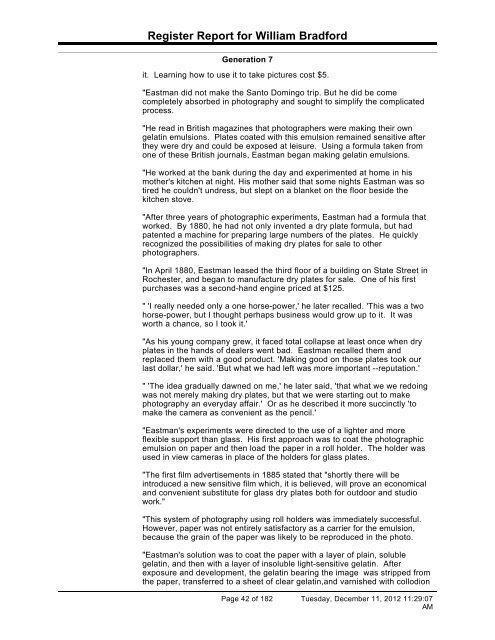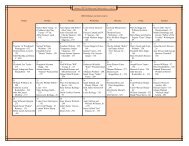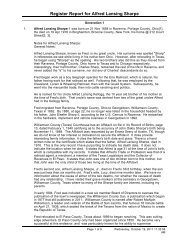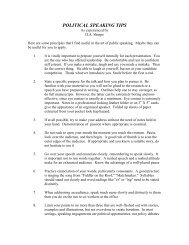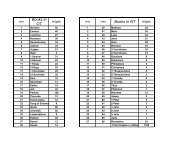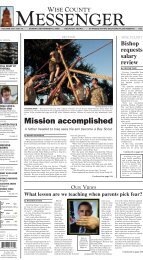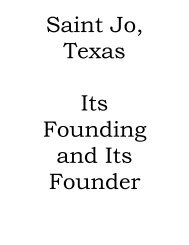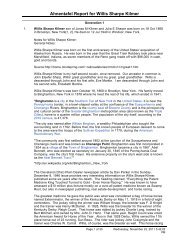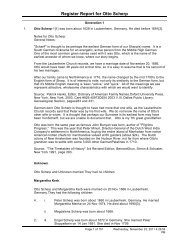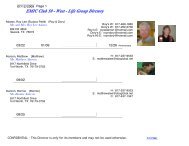My Descending from Gov. - D. A. Sharpe
My Descending from Gov. - D. A. Sharpe
My Descending from Gov. - D. A. Sharpe
Create successful ePaper yourself
Turn your PDF publications into a flip-book with our unique Google optimized e-Paper software.
Register Report for William Bradford<br />
Generation 7<br />
it. Learning how to use it to take pictures cost $5.<br />
"Eastman did not make the Santo Domingo trip. But he did be come<br />
completely absorbed in photography and sought to simplify the complicated<br />
process.<br />
"He read in British magazines that photographers were making their own<br />
gelatin emulsions. Plates coated with this emulsion remained sensitive after<br />
they were dry and could be exposed at leisure. Using a formula taken <strong>from</strong><br />
one of these British journals, Eastman began making gelatin emulsions.<br />
"He worked at the bank during the day and experimented at home in his<br />
mother's kitchen at night. His mother said that some nights Eastman was so<br />
tired he couldn't undress, but slept on a blanket on the floor beside the<br />
kitchen stove.<br />
"After three years of photographic experiments, Eastman had a formula that<br />
worked. By 1880, he had not only invented a dry plate formula, but had<br />
patented a machine for preparing large numbers of the plates. He quickly<br />
recognized the possibilities of making dry plates for sale to other<br />
photographers.<br />
"In April 1880, Eastman leased the third floor of a building on State Street in<br />
Rochester, and began to manufacture dry plates for sale. One of his first<br />
purchases was a second-hand engine priced at $125.<br />
" 'I really needed only a one horse-power,' he later recalled. 'This was a two<br />
horse-power, but I thought perhaps business would grow up to it. It was<br />
worth a chance, so I took it.'<br />
"As his young company grew, it faced total collapse at least once when dry<br />
plates in the hands of dealers went bad. Eastman recalled them and<br />
replaced them with a good product. 'Making good on those plates took our<br />
last dollar,' he said. 'But what we had left was more important --reputation.'<br />
" 'The idea gradually dawned on me,' he later said, 'that what we we redoing<br />
was not merely making dry plates, but that we were starting out to make<br />
photography an everyday affair.' Or as he described it more succinctly 'to<br />
make the camera as convenient as the pencil.'<br />
"Eastman's experiments were directed to the use of a lighter and more<br />
flexible support than glass. His first approach was to coat the photographic<br />
emulsion on paper and then load the paper in a roll holder. The holder was<br />
used in view cameras in place of the holders for glass plates.<br />
"The first film advertisements in 1885 stated that "shortly there will be<br />
introduced a new sensitive film which, it is believed, will prove an economical<br />
and convenient substitute for glass dry plates both for outdoor and studio<br />
work."<br />
"This system of photography using roll holders was immediately successful.<br />
However, paper was not entirely satisfactory as a carrier for the emulsion,<br />
because the grain of the paper was likely to be reproduced in the photo.<br />
"Eastman's solution was to coat the paper with a layer of plain, soluble<br />
gelatin, and then with a layer of insoluble light-sensitive gelatin. After<br />
exposure and development, the gelatin bearing the image was stripped <strong>from</strong><br />
the paper, transferred to a sheet of clear gelatin,and varnished with collodion<br />
Page 42 of 182 Tuesday, December 11, 2012 11:29:07<br />
AM


